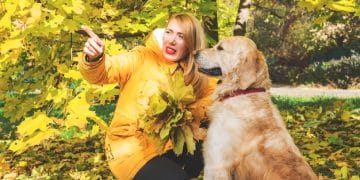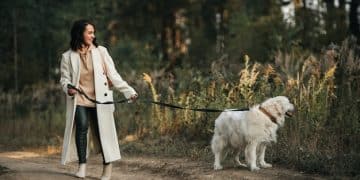Stop the Jump: How to Train Your Dog to Greet Guests Calmly
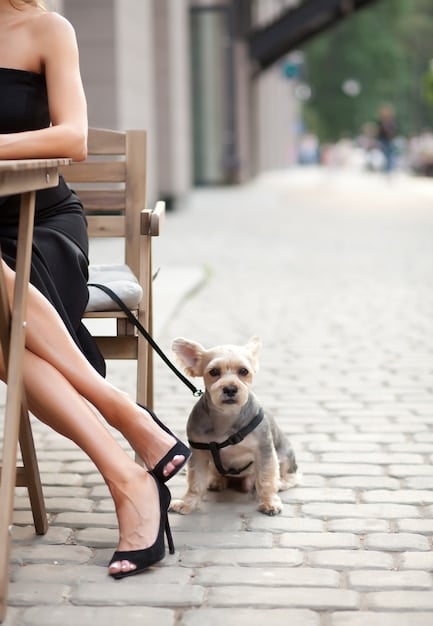
Anúncios
Teaching your dog to greet guests calmly, without jumping, involves consistent training techniques such as redirection, rewarding calm behavior, and managing the environment to promote a relaxed greeting.
Is your dog’s enthusiastic greeting more of a jump scare? While their intentions are pure, a jumping dog can be overwhelming, and even dangerous, for guests. Let’s explore how to teach your dog to greet guests calmly, replacing those leaps with polite paws on the ground.
Anúncios
Understanding Why Dogs Jump
Before diving into training, understanding the root cause of jumping is crucial. Dogs don’t jump to be dominant or naughty; it’s usually driven by excitement and attention-seeking behaviors.
When a dog jumps, they’re typically trying to get closer to your face, which is a natural behavior rooted in puppyhood. Puppies jump up to reach their mother’s face to lick and solicit attention. This behavior can persist into adulthood if not properly addressed.
Anúncios
The Attention Factor
One key reason dogs jump is to gain attention. Even negative attention, like a push or a shout, can reinforce the behavior. From the dog’s perspective, any reaction is better than being ignored.
Excitement and Energy
Jumping is also a way for dogs to release pent-up energy and excitement. This is especially common in breeds known for their high energy levels. A visitor arriving can trigger a surge of adrenaline, leading to exuberant jumping.
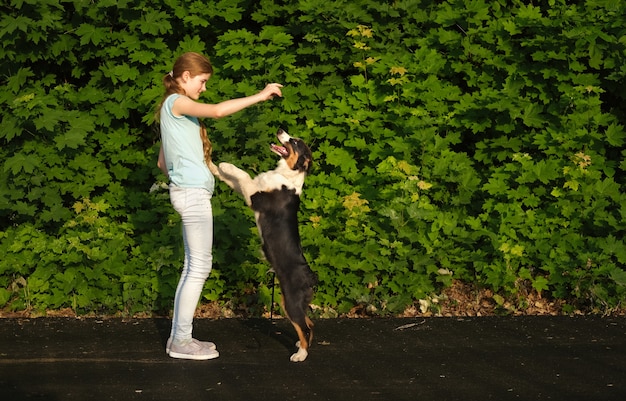
Understanding these motivations is the first step in changing your dog’s behavior. Now, let’s explore effective strategies to keep those paws on the ground.
Setting the Stage for Calm Greetings
Creating a calm environment is essential before your guests even arrive. This involves managing your dog’s energy and setting clear boundaries.
Prior to guests arriving, engage your dog in a physical activity to expend some of their energy. A brisk walk, a game of fetch, or even a short training session can help take the edge off their excitement.
- Pre-Arrival Exercise: A 20-30 minute walk can significantly reduce jumping behavior.
- Mental Stimulation: Puzzle toys or training exercises tire the brain and body.
- Safe Space: Designate a quiet area like a crate or bed where your dog can retreat if overwhelmed.
Controlled Entry
The way you handle the initial moments when a guest arrives can set the tone for the entire interaction. Keep your dog on a leash during greetings to maintain control and prevent jumping.
Using a Leash
A leash provides immediate control and allows you to guide your dog’s behavior. When the doorbell rings, calmly put your dog on the leash and keep them by your side.
By managing their excitement and establishing clear boundaries, you’re setting your dog up for success in greeting guests calmly.
Training Techniques to Stop Jumping
Effective training involves consistency, positive reinforcement, and clear communication. Here are some proven methods to curb jumping.
The key to successful training is to reward the behaviors you want to see. When your dog is calm and not jumping, offer praise, a treat, or a gentle pet. This positive reinforcement helps them associate calmness with rewards.
Redirection Techniques
Teach your dog an alternative behavior to jumping. This could be sitting, staying, or even fetching a toy. Redirection provides a positive outlet for their energy.
Another redirection technique involves using a verbal cue like “off” or “down” to signal your dog to stop jumping. Pair this cue with a physical guide, like gently pushing their rear end down, to help them understand the command.
- Reward Calmness: Praise and treats for paws on the ground.
- Ignore Jumping: Turn away or step back without making eye contact.
- Time-Outs: Briefly remove your dog from the situation if they continue to jump.
The Role of Guests in Training
Training isn’t just your responsibility; it also involves educating your guests on how to interact with your dog. Consistency across all interactions is essential for success.
Advise your guests to ignore your dog if they jump. Tell them to turn their back, fold their arms, and avoid eye contact until your dog has all four paws on the ground. Only then should they offer attention.
Consistent Rules
Make sure your guests understand the importance of consistency. If some guests encourage jumping while others discourage it, your dog will become confused, hindering the training process.
Guest Involvement
By involving your guests in the training process, you create a unified front that reinforces the desired behavior. Provide them with treats and instruct them to reward your dog for staying calm.
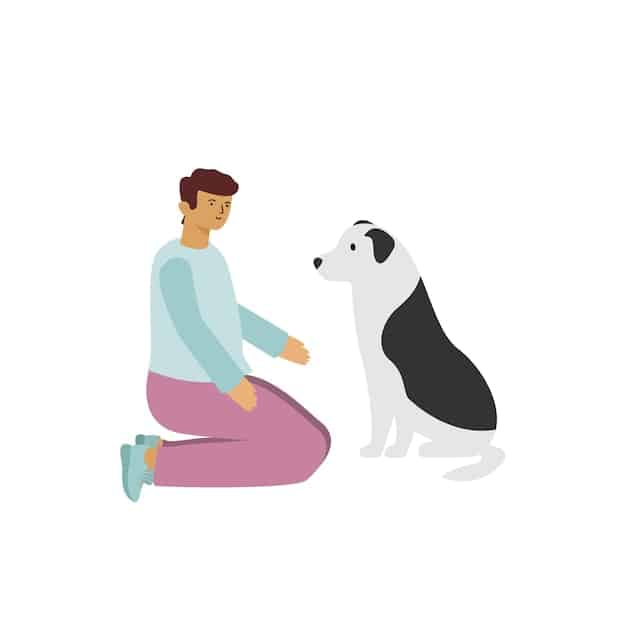
Enlisting the help of your guests can significantly accelerate your dog’s training progress. With everyone on board, your dog will learn that calm greetings are the only way to receive attention.
Dealing with Setbacks and Challenges
Training isn’t always a smooth journey. You may encounter setbacks and challenges along the way. It’s important to remain patient and adapt your approach as needed.
If your dog reverts to jumping after a period of improvement, don’t be discouraged. This is a normal part of the learning process. Analyze the situation to identify potential triggers and adjust your training accordingly.
Seeking Professional Help
If you’re struggling to make progress or your dog’s jumping is accompanied by other behavioral issues, consider seeking guidance from a professional dog trainer or behaviorist.
Consistency is Key
Remember, consistency is key to overcoming setbacks. Stick with your training plan, reinforce the rules, and celebrate small victories. With persistence, you can help your dog develop calm and polite greeting habits.
By addressing setbacks proactively and seeking support when needed, you can navigate the challenges of training and ultimately achieve your goal of a well-behaved dog.
Long-Term Maintenance and Reinforcement
Once your dog has learned to greet guests calmly, it’s important to continue reinforcing the behavior. Regular practice and consistent expectations will help maintain their good manners.
Continue to practice calm greetings regularly, even when guests aren’t present. This helps reinforce the learned behavior and prevents regression.
- Regular Practice: Schedule short training sessions to reinforce calm greetings.
- Vary Scenarios: Practice with different people and environments.
- Positive Reinforcement: Continue to reward calm behavior to maintain motivation.
By making calm greetings a routine part of your dog’s life, you’re ensuring that those polite paws stay firmly on the ground.
| Key Point | Brief Description |
|---|---|
| 🐶 Understand Jumping | Dogs jump due to excitement and seeking attention. |
| 🐾 Set Calm Stage | Exercise dog before guests arrive and use a leash for control. |
| 🏅 Consistent Training | Reward calm behavior, redirect jumping, and involve guests in training. |
| 🤝 Long-Term Reinforcement | Continue practicing calm greetings and reward desired behaviors to maintain good manners. |
FAQ
▼
Dogs typically jump to seek attention or express excitement. This behavior is often rooted in puppyhood when they jump to reach their mother’s face. Even negative attention can reinforce jumping.
▼
Consistently reward calm behavior, such as sitting or standing with all paws on the ground. Redirect jumping by teaching an alternative behavior. Enlist guests to ignore your dog until they are calm.
▼
Keep your dog on a leash during greetings to maintain control. Instruct guests to ignore your dog if they jump. Only give attention when all four paws are on the ground. Prior exercise can help.
▼
Punishment is generally not recommended as it can create fear and anxiety, potentially worsening the behavior. Positive reinforcement techniques, such as rewarding calm behavior, are more effective and humane.
▼
If you’re struggling to make progress or if jumping is accompanied by other behavioral issues, consult a professional dog trainer or behaviorist. They can provide tailored advice and support for your dog’s specific needs.
Conclusion
By understanding the reasons behind jumping and implementing consistent training techniques, you can effectively teach your dog to greet guests calmly. Remember, patience, positive reinforcement, and a collaborative approach with your guests are key to success. With dedication, you’ll transform those exuberant leaps into polite greetings, making visits enjoyable for everyone involved.



